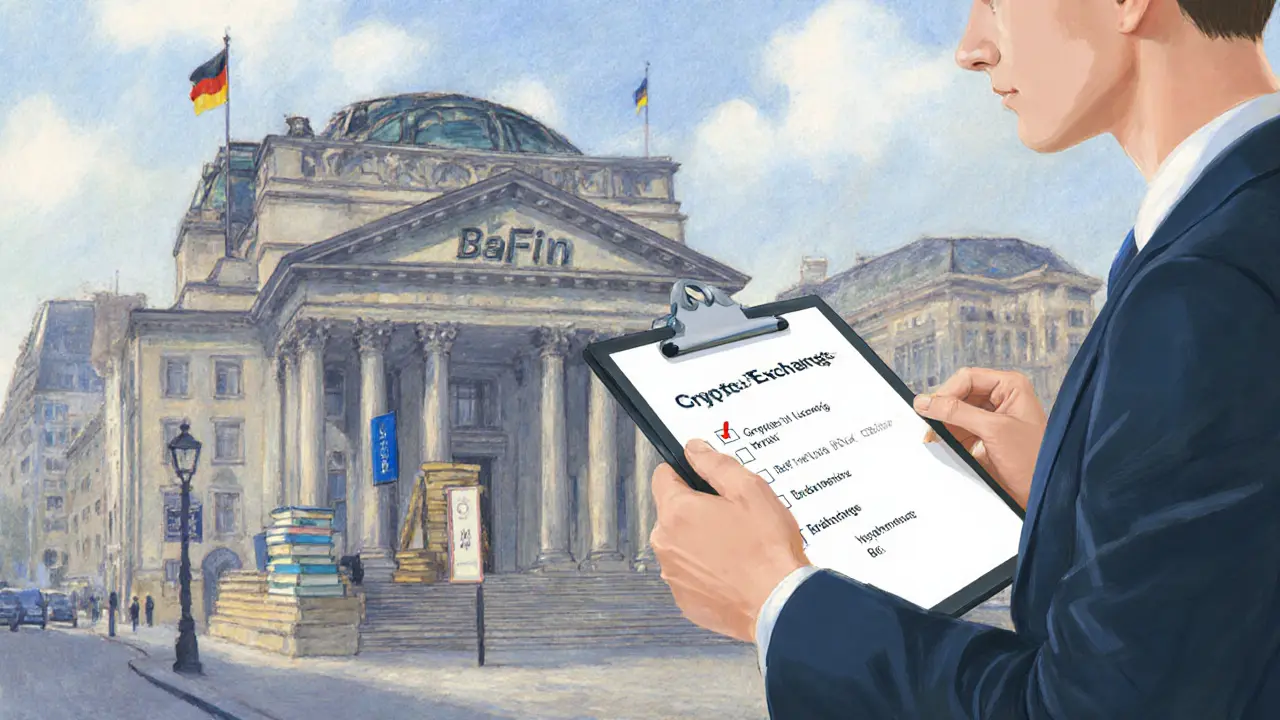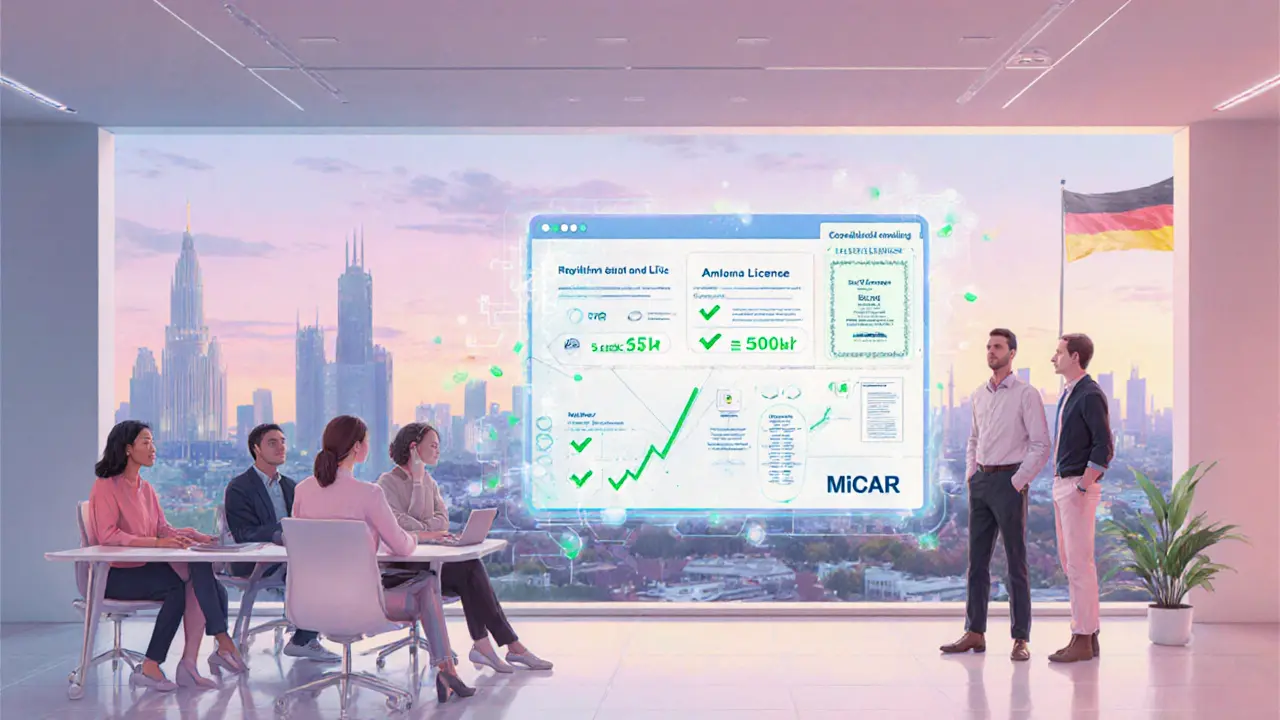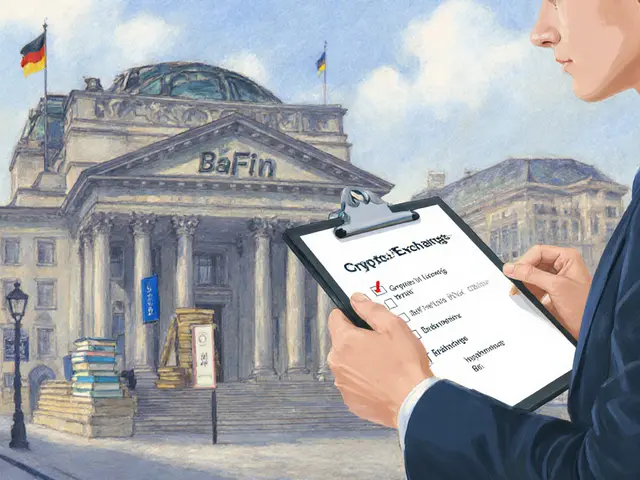German Crypto Exchange Regulations & Licensing Guide 2025

German Crypto Exchange Licensing Calculator
Your Compliance Summary
Token Classification Guide
Financial Instrument Tokens
Represent participation in a financial instrument, tradable on secondary markets
Regulated under German Securities Trading Act + MiFID IISecurity-like Tokens
Grant rights similar to shares or bonds
Regulated under German Securities Prospectus ActCapital Investment Tokens
Represent pooled investment in projects or funds
Regulated under German Capital Investment ActUtility/Payment Tokens
Used for accessing services or payments, not linked to underlying assets
Subject to MiCAR onlyTrying to launch a crypto exchange in Germany? You’ll quickly discover that the market isn’t just open - it’s tightly choreographed by a stack of laws, regulators, and European mandates. From BaFin’s strict licensing process to the EU‑wide MiCAR rules that took effect at the end of 2024, every step demands paperwork, tech safeguards, and a clear view of which token falls under which legal bucket. This guide walks you through the whole maze so you can focus on building the platform instead of guessing which rule applies.
Key Takeaways
- BaFin authorization is mandatory for any crypto‑asset service in Germany.
- MiCAR creates EU‑wide compliance standards that dovetail with national laws.
- Token classification (financial‑instrument, security‑like, capital‑investment) determines the exact legal regime.
- AML/KYC follows the KryptoWTransferV "travel rule" and FATF guidelines.
- Licensing steps: prepare documentation → submit to BaFin → tech audit → ongoing supervision.
Regulatory Landscape Overview
Germany’s crypto framework sits at the intersection of national legislation and EU‑wide directives. The core regulator, BaFin (the Federal Financial Supervisory Authority), enforces both German statutes and the MiCAR (Markets in Crypto‑Assets Regulation) that became fully applicable on 30December2024.
Two 2025 statutes tightened the domestic side: the FinmadiG (Act on the Digitalisation of the Financial Market) and the KMAG (Act on the Supervision of Markets for Crypto‑Assets). They introduced transitional rules for existing providers and aligned German processes with MiCAR.
How Tokens Are Classified
BaFin uses the token’s economic characteristics to route it to the correct legal regime:
| Token Type | Key Traits | Applicable Law |
|---|---|---|
| Financial‑instrument tokens | Represent participation in a financial instrument, tradable on secondary markets | German Securities Trading Act + MiFIDII |
| Security‑like tokens | Grant rights similar to shares or bonds | German Securities Prospectus Act |
| Capital‑investment tokens | Represent pooled investment in projects or funds | German Capital Investment Act |
| Utility/Payment tokens | Used for accessing services or payments, not linked to underlying assets | Subject to MiCAR only |
Correct classification drives the licensing path, reporting duties, and consumer‑protection measures you must embed.
Licensing Requirements from BaFin
Every entity that offers custody, trading, or exchange services for crypto‑assets needs a formal BaFin license. The authority checks three core pillars:
- Legal entity & governance - you must be a registered German GmbH, AG, or an EU‑registered subsidiary with a clear management structure.
- IT & security standards - robust cybersecurity architecture, multi‑factor authentication, encrypted key storage, and a documented incident‑response plan.
- Financial safeguards - segregation of client assets, minimum capital reserves (EUR125,000 for pure exchange services, higher if custodial duties are added), and insurance coverage for cyber‑theft.
Alongside these, MiCAR adds a white‑paper obligation. Before any public offering of a new crypto‑asset, you must submit a detailed prospectus‑style white paper to BaFin, describing the token’s economics, risk factors, and governance.

Anti‑Money‑Laundering (AML) & KYC Obligations
The KryptoWTransferV (German Crypto Asset Transfer Regulation) implements the FATF "travel rule" at the national level. It means you have to collect and forward both originator and beneficiary information for every on‑chain transfer that exceeds EUR1,000.
Key AML steps:
- Integrate a KYC solution that verifies ID documents, validates source‑of‑funds, and screens against sanction lists.
- Log transaction metadata (wallet address, IP, timestamps) and retain records for at least five years.
- Screen for structuring patterns - multiple sub‑EUR1,000 moves within a short window trigger a suspicious‑activity report (SAR) to the German Financial Intelligence Unit.
Failure to comply can result in fines up to 5% of annual turnover, as BaFin demonstrated in the June2025 winding‑up of Ethena GmbH (provider of USDe stablecoins).
Step‑by‑Step Licensing Process
Below is the practical flow most newcomers follow:
- Define service scope - decide whether you’ll offer pure exchange, custodial services, or both. This determines the capital reserve tier.
- Prepare documentation
- Business plan with market analysis (German market: ~90M adults, 5% crypto‑adoption).
- Organizational chart and board CVs.
- IT security architecture diagram.
- AML/KYC policy aligned with KryptoWTransferV.
- If issuing tokens, a MiCAR‑compliant white paper.
- Submit application via BaFin’s online portal. Pay the EUR3,500 filing fee.
- Technical audit - BaFin’s IT team inspects your infrastructure, penetration‑test reports, and key‑management procedures.
- Supervisory review - the regulator assesses governance, capital adequacy, and AML controls. Expect follow‑up queries within 30days.
- License issuance - if approved, you receive a 5‑year authorization, renewable upon proof of continued compliance.
- Ongoing reporting - quarterly financial statements, annual AML audit, and immediate notification of major incidents.
Tax Reporting & Compliance
Germany treats crypto‑transactions as taxable events. The March2025 tax circular clarified three core areas:
- Capital gains - realized profits from selling crypto are taxed at the personal income‑tax rate (0‑45%). The tax‑free allowance is EUR600 per year.
- Staking income - active staking rewards are taxable as “other income” at the personal rate; passive staking (where you simply hold tokens) is treated like interest.
- DeFi protocols - earnings from liquidity provision or yield farming are considered business income and require Gewerbeanmeldung (business registration).
Exchanges must provide users with a transaction overview using daily market rates, as required by the Federal Ministry of Finance’s circular on 6March2025. Failure to issue proper statements can trigger penalties of up to EUR50,000.
Practical Compliance Checklist
- Confirm legal entity registration in Germany or EU.
- Classify each token you intend to list and map it to the correct law.
- Develop a BaFin‑approved AML/KYC program aligned with KryptoWTransferV.
- Secure IT infrastructure - multi‑sig wallets, cold storage, regular penetration testing.
- Prepare capital reserve proof (EUR125k-500k depending on services).
- Draft MiCAR white paper for any new token offering.
- Submit the BaFin application and retain all supporting docs for 5years.
- Set up tax‑reporting pipelines that generate daily‑rate transaction logs.
Future Outlook
Expect the German regulator to tighten DeFi oversight in 2026, adding a licensing layer for protocol‑level services. The EU is also working on a supplemental “Delegated Regulation” to clarify stablecoin reserve requirements, which will feed back into BaFin’s supervision. For now, staying within the current framework - especially the BaFin licensing cycle and MiCAR compliance - gives you the best chance to scale across the EU without hitting legal roadblocks.

Frequently Asked Questions
Do I need a BaFin license if I only provide a peer‑to‑peer matching engine?
Yes. Even a pure matching service is considered a crypto‑asset service under BaFin’s definition and requires authorization unless the platform is strictly non‑custodial and does not hold user funds. Most operators choose to obtain the license to avoid legal uncertainty.
What capital reserve is mandatory for a German crypto exchange?
The baseline is EUR125,000 for a non‑custodial exchange. Adding custodial services raises the requirement to at least EUR250,000, and offering a wide range of token types can push it to EUR500,000.
How does MiCAR affect existing German crypto licences?
A grandfathering regime lets licences granted before 31December2025 continue operating, but holders must adapt their processes to meet MiCAR reporting and white‑paper standards by the end of 2025.
What are the AML record‑keeping requirements?
You must store all KYC data, transaction metadata, and SARs for a minimum of five years. Records must be accessible to BaFin upon request and encrypted at rest.
Are stablecoins treated differently under German law?
Stablecoins that qualify as electronic money require a license from BaFin’s banking supervisor. Those classed as utility tokens fall under MiCAR only. The Ethena GmbH case shows BaFin’s willingness to enforce compliance for stablecoin issuers.







Start with the capital reserve requirement – that’s the foundation for any German crypto exchange plan. The baseline EUR 125,000 for a non‑custodial platform is non‑negotiable, and it jumps to EUR 250,000 if you hold user assets. Getting the BaFin licence is a marathon, not a sprint, so set up a solid governance structure from day one. Treat the licensing checklist like a to‑do list you actually finish, and you’ll avoid costly delays. Keep the momentum, stay compliant and you’ll be ready to launch.
Looks like another bureaucratic maze 😂
It is imperative to recognize that the German regulatory framework operates under a strict hierarchical paradigm, wherein BaFin’s authorization serves as the pivotal gateway for any crypto‑asset service provider. The legislation delineates three distinct pillars: corporate governance, IT security, and financial safeguards; neglecting any one of these constitutes a breach of statutory duty. Moreover, the integration of MiCAR imposes an additional layer of compliance that aligns national statutes with overarching EU directives, thereby amplifying the complexity of the licensing process. Investors must be apprised that the capital reserve thresholds are not merely indicative figures but binding obligations enforceable by law, with sanctions ranging from monetary penalties to revocation of the operating licence. The AML/KYC regime, anchored in the KryptoWTransferV, mandates comprehensive data collection for transactions exceeding EUR 1,000, and the failure to transmit such information to the Financial Intelligence Unit will trigger severe punitive measures. Additionally, the requirement for a white‑paper under MiCAR introduces a prospectus‑style disclosure that must be vetted by BaFin prior to any token issuance, ensuring transparency and investor protection. In practice, firms should allocate dedicated legal and compliance teams to shepherd the application through BaFin’s multi‑stage review, which includes document submission, technical audit, and supervisory assessment. The timeline for approval can extend beyond ninety days, contingent upon the completeness of the dossier and responsiveness to regulator inquiries. Post‑licensing, continuous reporting obligations persist, encompassing quarterly financial statements, annual AML audits, and incident reporting protocols. Non‑compliance with these ongoing duties may culminate in escalated fines, calculated as a percentage of annual turnover, thereby jeopardizing the enterprise’s fiscal viability. Consequently, a proactive compliance strategy, underpinned by robust internal controls and regular regulatory monitoring, is essential to sustain operational legitimacy within the German market. Finally, prospective entrants should remain vigilant regarding forthcoming legislative amendments, particularly those targeting DeFi services, as the regulatory landscape is poised for further evolution in the coming years.
The token classification matrix is the linchpin of your compliance architecture; mis‑categorizing a security‑like token as a utility can trigger punitive enforcement. Aligning each asset with its governing statute – whether the Securities Trading Act, Prospectus Act, or MiCAR – is non‑negotiable. Deploy multi‑factor authentication and hardware‑security modules to meet BaFin’s IT audit criteria. Remember, segregation of client assets isn’t just good practice; it’s a regulatory mandate.
Picture this: a platform built on rock‑solid compliance, ready to scale across Europe. By mastering the licensing steps now, you free yourself from future legal shackles and can focus on innovation. The journey may feel like climbing a mountain, but each regulatory checkpoint is a foothold toward the summit. Embrace the process, celebrate each approved document, and let that momentum fuel your next product launch.
Submit the business plan, pay the fee, wait for the review.
The German market isn’t a playground for half‑baked ideas; it demands rigor, and anyone who tries to sidestep the capital reserve rules simply proves they don’t understand our financial sovereignty.
When you break down the licensing checklist, you’ll see it’s a mosaic of interconnected obligations – each piece brightens the picture of a compliant, trustworthy exchange. The capital reserve isn’t just a number; it’s a buffer that protects users and bolsters confidence in the marketplace. By embracing the AML/KYC framework, you not only satisfy BaFin but also champion the global fight against illicit finance. The MiCAR white‑paper requirement might feel like extra paperwork, yet it gives investors clarity and positions your platform as a beacon of transparency. In short, every regulatory brick you lay today constructs a sturdy edifice for tomorrow’s growth.
Token classification? Just a piece of regulatory paperwork 📄
Behind every compliance clause lies a silent echo of control, a reminder that freedom in finance is a carefully curated illusion.
Those who dismiss AML requirements are flirting with reckless negligence.
Keep the KYC flow smooth – a friendly onboarding experience builds trust 😊
The entire licensing circus is an overblown exercise in futility; seasoned operators should ignore it.
Regulation, in its essence, is a dialogue between innovation and societal safeguards; finding harmony is the true art.
One must unequivocally assert that the ostensible leniency afforded to utility tokens under MiCAR is a mere façade, masking an intricate lattice of concealed obligations.
Stay chill, follow the checklist, and you’ll be live before you know it.
Regulations just slow everything down.
Balancing compliance with user experience is key; a well‑designed interface can make even strict KYC feel seamless.
When drafting your AML policy, consider tiered risk assessments: low‑value retail users may need lighter checks, while institutional clients demand deeper scrutiny. Additionally, integrate automated transaction monitoring tools that flag structuring patterns in real time. Regular audits of these systems will keep you ahead of BaFin’s supervisory expectations and reduce the likelihood of SAR penalties.
It’s a bit tiring having to repeat the same compliance steps over and over.
Respect the regulator’s timeline, but also push for clarity in their feedback – it benefits everyone.
Keep the momentum, stay focused on the checklist, and the licence will be yours before the next quarter.